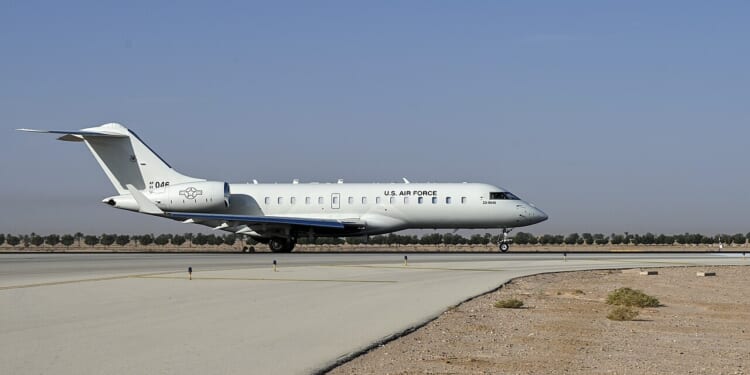The BACN has been employed in over 15,500 missions to date, and the BACN Gateway has a mission availability rate exceeding 98 percent.
Bombardier Defense doesn’t produce fighter jets or even bombers, but the aerospace firm does produce an aircraft that could be equally important in a future war. Its E-11A serves as a manned Battlefield Airborne Communications Node (BACN). This high-altitude communication gateway has been described as “Wi-Fi in the sky” for its ability to enhance the situational awareness and interoperability of United States Air Force assets.
This month, the ninth E-11A was delivered to the air service at Hanscom Air Force Base (AFB), Mass.
“At Bombardier Defense, we are honored to see our reliable, high-performing Global aircraft serve the United States Air Force in critical missions worldwide through the BACN program,” said Jean-Christophe Gallagher, executive vice president, Aircraft Sales and Bombardier Defense. “We are grateful for the longstanding trust of the US Air Force, and we look forward to continuing to support the operational needs of the United States.”
The E-11A BACN Aircraft’s History
The United States Air Force initially developed the BACN program in 2008 and leased the first E-11A in 2009, from which it was tested at Kandahar Airfield in Afghanistan. Based on the Bombardier Aviation Global 6000, a large-cabin corporate jet, it was transformed into a flying communication node and performed well enough in the role that two years later, the Air Force bought the original BACN-Global Express aircraft and then purchased three more.
By 2019, the E-11A fleet had accumulated more than 100,000 flight hours; however, one of the original four aircraft was lost in early 2020 in Ghazni Province, Afghanistan.
The crash killed Lt. Col. Paul K. Voss and Capt. Ryan S. Phaneuf, both assigned to the 430th Expeditionary Combat Squadron at Kandahar Airfield, Afghanistan.
The Air Force Wants to Buy More BACNs
In 2021, the US Air Force awarded a $464.8 million contract to Bombardier for six additional E-11A BACN aircraft. Assigned to the Air Combat Command (ACC), the aircraft can operate as a high-altitude, loitering communications node to air and ground forces.
Each of the Air Force’s E-11A can provide a node for voice communication, as well as a crucial link to share data, video, and images. The payload can also provide relay, bridging, and data translation for platforms that are unable to communicate due to terrain impediments, including units separated by mountains. This is why the aircraft proved so vital in Afghanistan, where terrestrial communications were limited.
The E-11A is noted for employing different link systems for voice and data, which helps address issues including latency and security.
The US Air Force’s entire E-11A fleet is based at Hanscom AFB, but is deployed around the world as the need arises.
In addition to the nine E-11A manned aircraft currently in service, the US Air Force also operates four MQ-4 B Global Hawk unmanned aerial vehicle (UAV) drones, each equipped with Northrop Grumman’s Battlefield Airborne Communications Node payload.
The BACN has been employed in over 15,500 missions to date, and the BACN Gateway has a mission availability rate exceeding 98 percent.
About the Author: Peter Suciu
Peter Suciu has contributed over 3,200 published pieces to more than four dozen magazines and websites over a 30-year career in journalism. He regularly writes about military hardware, firearms history, cybersecurity, politics, and international affairs. Peter is also a contributing writer for Forbes and Clearance Jobs. He is based in Michigan. You can follow him on Twitter: @PeterSuciu. You can email the author: [email protected].
Image: Wikimedia Commons.

















